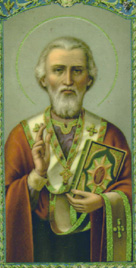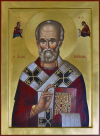Real News Links
Well-Known Member
The great veneration with which St. Nicholas has been honored for many ages and the number of altars and churches all over the world that are dedicated in his memory are testimonials to his wonderful holiness and the glory he enjoys with God. As an episcopal see, and his childhood church falling vacant, the holy Nicholas was chosen bishop, and in that station became famous by his extraordinary piety and zeal and by his many astonishing miracles. The Greek histories of his life agree he suffered an imprisonment of the faith and made a glorious confession in the latter part of the persecution raised by Dioletian, and that he was present at the Council of Nicaea and there condemned Arianism. It is said that St. Nicholas died in Myra, and was buried in his cathedral.
St. Nicholas' episcopate at Myra during the fourth century is really all that appears indubitable authentic, according to Alban Butler, an English Roman Catholic priest from the 1700s. This is not for lack of material, beginning with the life attributed to the monk who died in 847 as St. Methodius, Patriarch of Constantinople. Nevertheless, the universal popularity of the saint for so many centuries requires that some account of the legends surrounding his life should be given.
St. Nicholas, also known as "Nikolaos of Myra," was a fourth century saint and Greek bishop of Myra. Nicholas was born in Asia Minor in the Roman Empire as an only child to Christian parents. Nicholas would take nourishment only once on Wednesdays and Fridays, and that in the evening according to the canons. "He was exceedingly well brought up by his parents and trod piously in their footsteps. The child, watched over by the church, enlightened his mind and encouraged his thirst for sincere and true religion." Both of his parents tragically died during an epidemic when he was a young man, leaving him well off, but to be raised by his uncle - the Bishop of Patara. Nicholas was determined to devote his inheritance to works of charity, and his uncle mentored him as a reader and later ordained him as a presbyter (priest).
An opportunity soon arose for St. Nicholas and his inheritance. A citizen of Patara had lost all his money, and needed to support his three daughters who could not find husbands because of their poverty; so the wretched man was going to give them over to prostitution. Nicholas became informed of this, and thus took a bag of gold and threw it into an open window of the man's house in the night. Here was a dowry for the eldest girl and she was soon duly married. At intervals Nicholas did the same for the second and the third; at the last time the father was on the watch, recognized his benefactor and overwhelmed Nicholas with his gratitude. It would appear that the three purses represented in pictures, came to be mistaken for the heads of three children and so they gave rise to the absurdstory of the children, resuscitated by the saint, who had been killed by an innkeeper and pickled in a brine-tub.
Coming to the city of Myra when the clergy and people of the province were in session to elect a new bishop, St. Nicholas was indicated by God as the man they should choose. This was during the time of persecutions in the beginning of the fourth century and "as he [Nicholas] was the chief priest of the Christians of this town and preached the truths of faith with a holy liberty, the divine Nicholas was seized by the magistrates, tortured, then chained and thrown into prison with many other Christians. But when the great and religious Constatine, chosen by God, assumed the imperial diadem of the Romans, the prisoners were released from their bonds and with them the illustrious Nicholas, who when he was set at liberty returned to Myra."
More:

St. Nicholas - Saints & Angels - Catholic Online
The great veneration with which St. Nicholas has been honored for many ages and the number of altars and churches all over the world that are dedicated in his memory are testimonials to his wonderful holiness and the glory he enjoys with God. As an episcopal see, and his childhood church falling ...

